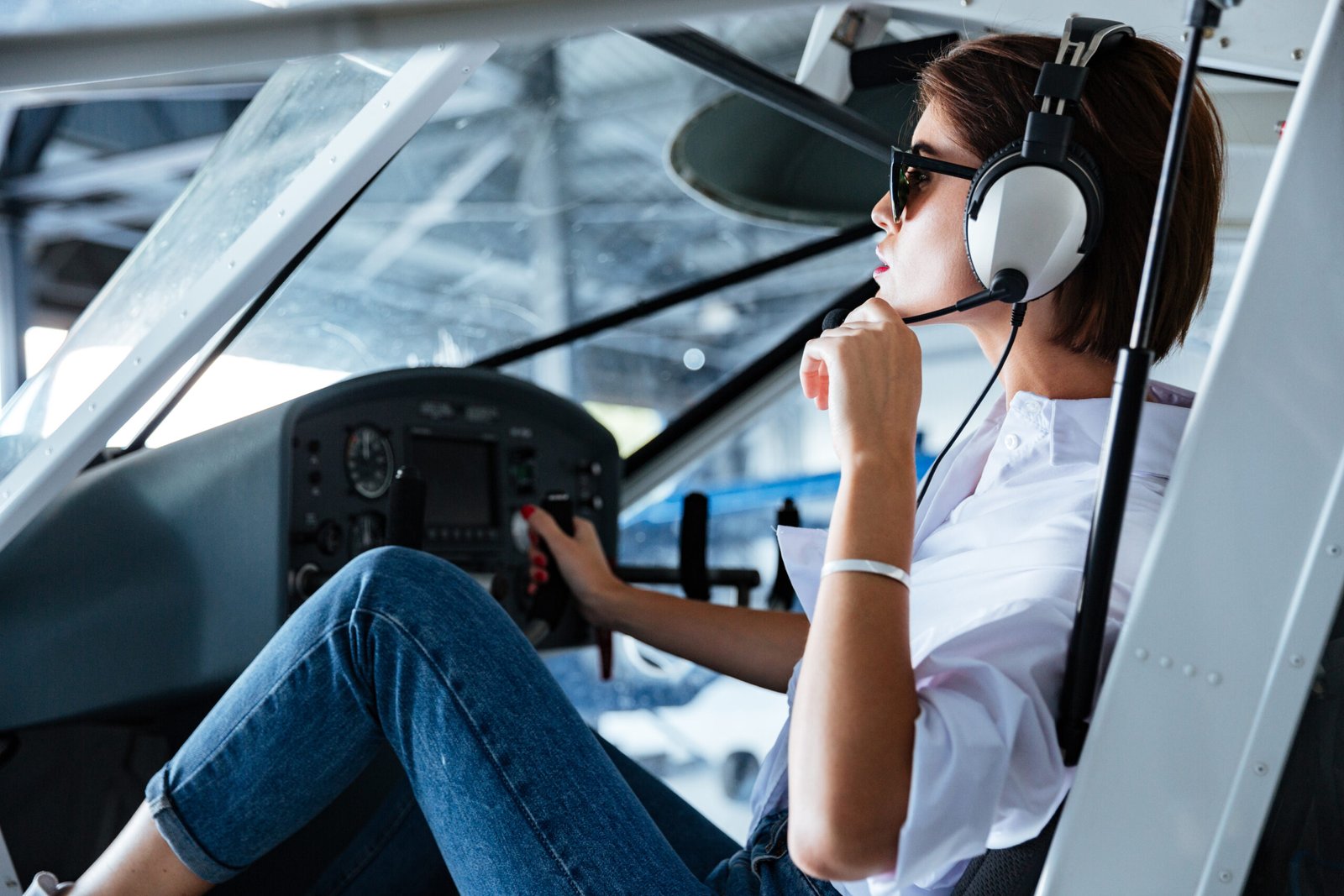FAA
A Journey Through the Skies: The Most Iconic Aircraft of All Time
Aviation, an enthralling blend of technology and artistry, has captured human imagination for over a century. From the Wright brothers’ first powered flight to modern jets that carve through the sky, aircraft have transformed how we traverse our planet. But to truly appreciate these iconic machines, one must first understand the foundation they stand upon—the education and resources available for aspiring aviators.
### Aviation Schools: Types of Courses
Before embarking on a journey through the skies, future pilots often seek knowledge at aviation schools. These institutions offer a broad array of courses designed to cater to various career paths within aviation.
*1. Private Pilot License (PPL)**
This is where many begin their flying journey. The PPL course covers essential flight training along with ground school topics such as navigation, regulations, and meteorology.
*2. Commercial Pilot License (CPL)**
For those looking to turn their passion into a profession, CPL programs delve deeper into advanced flight maneuvers and complex airspace management.
*3. Airline Transport Pilot License (ATPL)**
The pinnacle of pilot certification, ATPL prepares individuals for commanding commercial airliners, involving rigorous training on multi-engine aircraft.
*4. Flight Instructor Certification**
Many choose to become Certified Flight Instructors (CFI), allowing them not only to fly but also impart their knowledge onto others—creating a new generation of aviators.
In addition to these licenses, specialized courses in aeronautical engineering, aviation management, and air traffic control are also widely available across various institutions.
### Engaging with Aviation Online: Blogs and Social Media
With the digital age in full swing, numerous online platforms exist that cater to both seasoned pilots and aviation enthusiasts alike. Here’s a collection of valuable blogs and websites:

**Airliners.net:** An extensive database featuring photographs and discussions centered around various aircraft.
**Flying Magazine:** A publication dedicated to all things flying—from gear reviews to personal stories from pilots.
**The Points Guy:** While primarily focused on travel points and rewards, this site offers incredible insights into airline operations.
**Aviation Week:** Stay updated on industry news with articles covering everything from technology advancements to regulatory changes.
Social media provides another engaging avenue for those passionate about aviation:
**Instagram Accounts like @aviationdaily** showcase breathtaking aerial shots.
**YouTube Channels like ‘FlightChops’** give viewers immersive flight experiences through entertaining vlogs.
**Reddit’s r/flying community** allows for discussion among both novice aviators and experienced pilots alike.
### FAA Flight Schools: Simulators & Training
In the United States, FAA-approved flight schools are recognized as gold standards in pilot training. These establishments adhere strictly to safety regulations while providing top-notch instruction using state-of-the-art simulators alongside real aircraft training.
Simulators offer invaluable experience without leaving the ground—students can practice emergency landings or adverse weather conditions safely before taking their skills aloft. With increasingly sophisticated technologies mimicking real-life scenarios down to minute details such as instrument readings and environmental factors, students can hone their abilities effectively before reaching for the clouds.
Whether pursuing a recreational license or aiming high in an airline captaincy role, understanding these educational pathways enriches any aviator’s journey. As you prepare for takeoff into your own aviation adventure or simply appreciate some legendary planes soaring above—take heart; each iconic aircraft represents not just metal and machines but dreams realized against the backdrop of endless skies!
Flight Paths: Explore the Most Breathtaking Airports Around the World
When it comes to aviation, there’s more than just soaring through the skies and landing safely; it’s about the journey that begins long before takeoff. Aspiring pilots and aviation enthusiasts often find themselves navigating a maze of educational options, online resources, and flight schools. This post will guide you through diverse aviation schools, essential online platforms, and insights into FAA-approved flight training.
*Aviation Schools by Types of Courses**
The world of aviation education is rich and varied, catering to different interests and career aspirations. Here’s a brief overview of common course types:
1. **Pilot Training Programs**: These are designed for those who dream of taking control of an aircraft. From private pilot licenses (PPL) to commercial pilot licenses (CPL), these programs cover everything from basic navigation skills to advanced aerodynamics.

2. **Aircraft Maintenance Engineering**: For those inclined towards the technical side, this program focuses on maintaining and repairing aircraft systems. Understanding mechanical engineering principles ensures that planes remain safe for travel.
3. **Aviation Management**: This course is ideal for individuals looking to dive into airport operations or airline management. It covers operational procedures, regulatory requirements, and business strategies in the aviation sector.
4. **Air Traffic Control Training**: A vital component of airspace safety, air traffic control training teaches students how to manage aircraft movements efficiently while ensuring safety protocols are followed.
5. **Flight Dispatch Programs**: This field involves planning flight routes, fuel loads, and weather considerations. Dispatchers play a crucial role in ensuring smooth operations behind the scenes.
Each type offers unique insights into different facets of aviation, allowing students to tailor their education according to their passions.
*Lists of Aviation Blogs, Websites, Social Media Sites**
In today’s digital age, staying updated with aviation trends is easier than ever with numerous blogs and websites dedicated to this field:
**Airliners.net**: A go-to site for plane spotters featuring thousands of photos from around the globe.
**Flying Magazine Blog**: Offers articles on flying techniques as well as product reviews.
**Jetwhine.com**: A blog focusing on industry developments along with thought-provoking commentary.
**Aviation Week Network**: Provides news articles focused on aerospace technology advancements.
Social media also plays a pivotal role in connecting aviators worldwide:
Follow hashtags like #AvGeek on Twitter or Instagram for stunning aerial imagery shared by fellow enthusiasts.
Facebook groups such as “Pilots’ Lounge” or “General Aviation” foster community discussions ranging from flying tips to industry news.
*FAA Flight Schools / Airplane Schools / Simulators**
Choosing an FAA-approved flight school is paramount for receiving quality training recognized across the United States—and beyond! Look for institutions that offer both ground school instruction alongside practical flight experiences using advanced simulators.
Simulators provide an invaluable tool for budding pilots—they allow trainees to practice maneuvers without leaving the ground while experiencing real-life scenarios in a controlled environment. Notable FAA-certified institutions include:
**Embry-Riddle Aeronautical University**
**Purdue University**
**California State University – Los Angeles**
These schools not only equip students with hands-on experience but also connect them with industry professionals through internships and networking events.
In conclusion, whether your heart races at the thought of piloting an aircraft or managing daily airport operations from afar, there’s no shortage of avenues within aviation waiting to be explored. Embrace your passion by diving deep into education resources—your flight path awaits!

Soaring High: The Future of Sustainable Aviation Technology
As we stand on the brink of a new era in aviation, sustainable technology is taking center stage. With increasing awareness of environmental impacts and the urgent need for greener alternatives, the aviation industry is undergoing tremendous transformation. But where does one begin this journey into the skies? Let’s explore some avenues through which aspiring aviators can prepare for a sustainable future, including various types of aviation schools, valuable online resources, and FAA-certified training options.
*Aviation Schools: A Diverse Array of Courses**
In navigating the path to a career in aviation, it’s essential to understand the variety of educational opportunities available. Aviation schools offer courses tailored to different interests and career goals.
1. **Pilot Training Programs**: These are foundational courses designed for those who wish to become pilots. They typically cover flight theory, navigation skills, and practical flight experience with various aircraft types.
2. **Aviation Management**: For those interested in the business side of flying, these programs delve into airport management, airline operations, and regulatory issues while emphasizing sustainability practices.
3. **Air Traffic Control (ATC)**: ATC courses teach students about managing air traffic flow safely and efficiently—an increasingly vital skill as air travel expands.
4. **Aircraft Maintenance Engineering**: Here, students learn about maintaining and repairing aircraft systems. Emphasis on sustainable practices ensures that future mechanics are well-versed in green technologies.
5. **Drone Technology**: With drones revolutionizing sectors from agriculture to delivery services, specialized courses equip learners with knowledge about UAV operations and regulations.
Each type of program offers a unique perspective on how sustainability can be integrated into everyday aviation practices.
*Valuable Online Resources for Aspiring Aviators**
The digital world is brimming with information that can guide your aviation journey:
**Aviation Blogs**: Websites like *Airways Magazine* or *Flying Magazine* provide insights into industry trends and innovations in sustainable technology.
**Educational Sites**: Platforms such as *Flight School Simulator* offer realistic training experiences through advanced simulators that help students grasp complex flight scenarios without ecological footprints.
**Social Media Groups**: Following accounts like @TheAviationBuzz or joining Facebook groups related to pilot training can connect you with a community passionate about aviation advancements.
These platforms not only keep enthusiasts informed but also foster networking opportunities that are crucial in this fast-evolving field.
*FAA Flight Schools and Simulators**
For hands-on training aligned with federal regulations, enrolling in FAA-approved flight schools is essential. These institutions adhere strictly to safety standards while offering quality education across various disciplines within aviation.
Many FAA-certified schools incorporate cutting-edge simulators into their curriculum. Simulators provide invaluable practice without emissions associated with actual flights—ideal for honing skills while minimizing environmental impact.
Additionally, certain flight schools emphasize eco-friendly flying techniques by teaching energy-efficient flying methods or utilizing aircraft powered by alternative fuels. This focus prepares pilots to approach their careers with sustainability at the forefront.

As we look toward the horizon of aviation’s future, it’s clear that education plays an integral role in ushering in a new age defined by innovation and responsibility. Whether you’re dreaming of soaring through clouds or managing airport operations from behind a desk, the pathways toward contributing positively to our planet are more accessible than ever before! Join us as we embrace these transformative changes—the sky truly is no longer the limit!
The Science of Soaring: Understanding Aerodynamics in Aviation
Aviation is a mesmerizing field that combines technology, science, and the thrill of flight. At the heart of this discipline lies aerodynamics—the study of how air interacts with moving objects. To navigate the skies, future aviators must first understand this critical science. However, mastering aerodynamics goes hand-in-hand with formal education and continuous learning through various courses and resources available.
### Types of Aviation Schools and Courses
Whether you’re aiming to become a pilot, aircraft mechanic, or air traffic controller, there’s an array of aviation schools offering specialized programs tailored to diverse career paths. Here are some key types:
1. **Flight Schools**: These are dedicated institutions where aspiring pilots learn the skills necessary for flight operations. Programs typically range from private pilot licenses to commercial flying certifications.
2. **Technical Schools**: For those interested in aircraft maintenance, technical schools provide hands-on training in aviation mechanics and engineering principles.
3. **Universities**: Many universities offer comprehensive aviation degrees that cover various facets of the industry—including flight operations, management, safety protocols, and more.
4. **Online Learning Platforms**: With digital education thriving, several online platforms now provide courses on aerodynamics, navigation systems, and aircraft operations—perfect for self-paced learners or those with busy schedules.
Choosing the right course can set the foundation for a successful career in aviation while fostering an in-depth understanding of aerodynamics.
### A Treasure Trove of Aviation Resources
In today’s digital world, staying updated on aviation trends is easier than ever thanks to numerous blogs and websites dedicated to all things flight-related. Here’s a list to enhance your knowledge:
**Aviation Week Network**: This site offers insights into aerospace news covering everything from technology advancements to regulatory updates.
**Flying Magazine**: A publication focusing on general aviation that includes articles on flying techniques as well as equipment reviews.
**Airliners.net**: An extensive community resource featuring photographs and discussions about aircraft around the globe.
**Pilot’s Discretion Podcast**: An engaging podcast where seasoned pilots share their experiences while discussing industry-related topics.
To connect with fellow aviation enthusiasts or professionals alike, social media platforms serve as vibrant forums:
**Instagram & Twitter (#aviation)**: Follow hashtags like #aviation or accounts dedicated to flight enthusiasts for stunning imagery and snippets from across the globe.
**Facebook Groups (e.g., Pilots & Aircraft Owners)**: Join groups focused on specific interests within aviation—from pilot training tips to aircraft ownership advice.
These resources not only provide valuable insights but also foster community engagement among those passionate about flight.
### FAA Flight Schools and Simulator Training
For anyone serious about becoming a pilot in the United States, enrolling in FAA-approved flight schools is paramount. These institutions adhere strictly to federal regulations ensuring students receive top-notch training aligned with safety standards.

Many FAA flight schools offer simulator training—a crucial component in contemporary pilot education. Simulators allow students to practice emergency situations without any real-world risks involved; they replicate varied weather conditions and various aircraft types enabling thorough preparation before stepping into an actual cockpit!
In conclusion, embarking on a journey through aviation requires more than just dreams; it demands dedication to understanding complex concepts like aerodynamics paired with quality education from reputable institutions. By utilizing various educational pathways alongside abundant online resources—future aviators can confidently navigate their way toward soaring success!
The Sky’s the Limit: Exploring the Future of Aviation Technology
As we soar into an era defined by rapid technological advancements, aviation is on the brink of a transformative leap. The future promises not just innovations in aircraft design and performance but also profound changes in how aspiring aviators are trained. For those eager to take to the skies, understanding the diverse pathways available through aviation schools can be a game-changer.
Aviation education is not one-size-fits-all; it encompasses various types of courses that cater to different interests and career goals. **Pilot training programs**, for instance, are often the most sought after. These typically include Private Pilot Certificates, Instrument Ratings, and Commercial Pilot Licenses. For those drawn to behind-the-scenes operations, **air traffic control courses** offer specialized training in managing air traffic safely and efficiently. Additionally, **aviation management programs** provide insights into the business side of flying—perfect for future executives looking to steer airlines or airports.
If your passion leans towards engineering or technology, consider enrolling in **aviation maintenance technician programs**. These courses dive deep into aircraft systems and maintenance protocols, ensuring safety remains paramount. Furthermore, with drone technology rising exponentially in popularity, many institutions now offer courses specifically focused on Unmanned Aircraft Systems (UAS). This exciting area is shaping up to be a cornerstone of modern aviation.

Navigating this educational landscape requires reliable resources to stay informed about industry trends and technologies. A plethora of aviation blogs and websites can offer insightful perspectives on everything from policy changes to emerging tech innovations. Some standout blogs include *AirlineReporter*, which keeps enthusiasts updated on airline news with a touch of humor and personal anecdotes. Meanwhile, *The Air Current* dives deep into industry analysis with expert opinions that can shape your understanding of the market.
Social media platforms also serve as vibrant communities for aviation lovers. LinkedIn groups focused on specific sectors—like commercial piloting or aerospace engineering—provide networking opportunities that could lead directly to job prospects post-graduation. Instagram features stunning imagery from pilots showcasing breathtaking views from above #AvGeek style; follow accounts like @FlyingWithFish or @FlightChops for daily inspiration!
For hands-on experience essential for becoming a skilled pilot or technician, pursuing an FAA-approved flight school is critical. Many flight schools across the country meet rigorous standards set by the Federal Aviation Administration (FAA), ensuring students receive top-notch training in both practical skills and safety protocols. Schools like *ATP Flight School* offer accelerated programs designed for those who want to earn their licenses swiftly while still being thorough in their instruction.
In addition to traditional flight schools, innovative simulator training facilities have emerged as vital resources for developing skills without leaving the ground. Advanced simulators replicate real-world flying conditions without risking lives or aircraft; they allow students to practice emergency procedures extensively before taking off solo.
As we look ahead at all these developments within aviation education and technology—whether it’s through traditional schooling methods or cutting-edge simulation—it’s clear that we’re only beginning our journey toward redefining what it means to fly.

In conclusion, whether you’re aiming high as a pilot or grounded in management roles within aviation industries, there’s no shortage of paths to explore—the sky truly is limitless! Embrace these opportunities as they unfold—they might just pave your way toward soaring success!




